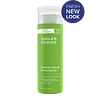What's inside
What's inside
 Key Ingredients
Key Ingredients

No key ingredients
 Benefits
Benefits

 Concerns
Concerns

 Ingredients Side-by-side
Ingredients Side-by-side

Water
Skin ConditioningGlycerin
HumectantSodium Lauryl Glucose Carboxylate
CleansingSodium Cocoyl Amino Acids
CleansingLauryl Glucoside
CleansingDecyl Glucoside
CleansingAcrylates/C10-30 Alkyl Acrylate Crosspolymer
Emulsion StabilisingCocamidopropyl Betaine
CleansingCitrus Aurantium Amara Flower Water
MaskingButylene Glycol
HumectantHexylene Glycol
EmulsifyingParfum
MaskingCitric Acid
BufferingSodium Benzoate
MaskingDisodium EDTA
Sorbic Acid
PreservativeSynthetic Fluorphlogopite
Tetrasodium Glutamate Diacetate
CI 77891
Cosmetic ColorantMaltodextrin
AbsorbentMoringa Oleifera Seed Extract
Skin ConditioningSpiraea Ulmaria Extract
AstringentPotassium Sorbate
PreservativeTin Oxide
AbrasiveCI 42090
Cosmetic ColorantWater, Glycerin, Sodium Lauryl Glucose Carboxylate, Sodium Cocoyl Amino Acids, Lauryl Glucoside, Decyl Glucoside, Acrylates/C10-30 Alkyl Acrylate Crosspolymer, Cocamidopropyl Betaine, Citrus Aurantium Amara Flower Water, Butylene Glycol, Hexylene Glycol, Parfum, Citric Acid, Sodium Benzoate, Disodium EDTA, Sorbic Acid, Synthetic Fluorphlogopite, Tetrasodium Glutamate Diacetate, CI 77891, Maltodextrin, Moringa Oleifera Seed Extract, Spiraea Ulmaria Extract, Potassium Sorbate, Tin Oxide, CI 42090
Water
Skin ConditioningDecyl Glucoside
CleansingGlycerin
HumectantSodium Cocoamphoacetate
CleansingLauryl Glucoside
CleansingXanthan Gum
EmulsifyingCoco-Glucoside
CleansingGlucose
HumectantSodium Cocoyl Glutamate
CleansingSodium Lauryl Glucose Carboxylate
CleansingGlyceryl Oleate
EmollientAloe Barbadensis Leaf Juice
Skin ConditioningCarrageenan
Sodium Phytate
Citric Acid
BufferingEthylhexylglycerin
Skin ConditioningPhenoxyethanol
PreservativePotassium Sorbate
PreservativeWater, Decyl Glucoside, Glycerin, Sodium Cocoamphoacetate, Lauryl Glucoside, Xanthan Gum, Coco-Glucoside, Glucose, Sodium Cocoyl Glutamate, Sodium Lauryl Glucose Carboxylate, Glyceryl Oleate, Aloe Barbadensis Leaf Juice, Carrageenan, Sodium Phytate, Citric Acid, Ethylhexylglycerin, Phenoxyethanol, Potassium Sorbate
Ingredients Explained
These ingredients are found in both products.
Ingredients higher up in an ingredient list are typically present in a larger amount.
Citric Acid is an alpha hydroxy acid (AHA) naturally found in citrus fruits like oranges, lemons, and limes.
Like other AHAs, citric acid can exfoliate skin by breaking down the bonds that hold dead skin cells together. This helps reveal smoother and brighter skin underneath.
However, this exfoliating effect only happens at high concentrations (20%) which can be hard to find in cosmetic products.
Due to this, citric acid is usually included in small amounts as a pH adjuster. This helps keep products slightly more acidic and compatible with skin's natural pH.
In skincare formulas, citric acid can:
While it can provide some skin benefits, research shows lactic acid and glycolic acid are generally more effective and less irritating exfoliants.
Most citric acid used in skincare today is made by fermenting sugars (usually from molasses). This synthetic version is identical to the natural citrus form but easier to stabilize and use in formulations.
Read more about some other popular AHA's here:
Learn more about Citric AcidDecyl Glucoside is a glucose-based surfactant and emulsion stabilizer. It is created by reacting glucose with the fatty acids from plants.
Surfactants help clean the skin by trapping oil, sebum, and dirt to be washed away. As an emulsion stabilizer, it stabilizes the ingredients in a product by preventing them from separating.
This ingredient is biodegradable and non-toxic. This ingredient is commonly found in baby shampoos.
Decyl Glucoside is sometimes used to stabilize the UV filter Tinosorb.
Learn more about Decyl GlucosideGlycerin is already naturally found in your skin. It helps moisturize and protect your skin.
A study from 2016 found glycerin to be more effective as a humectant than AHAs and hyaluronic acid.
As a humectant, it helps the skin stay hydrated by pulling moisture to your skin. The low molecular weight of glycerin allows it to pull moisture into the deeper layers of your skin.
Hydrated skin improves your skin barrier; Your skin barrier helps protect against irritants and bacteria.
Glycerin has also been found to have antimicrobial and antiviral properties. Due to these properties, glycerin is often used in wound and burn treatments.
In cosmetics, glycerin is usually derived from plants such as soybean or palm. However, it can also be sourced from animals, such as tallow or animal fat.
This ingredient is organic, colorless, odorless, and non-toxic.
Glycerin is the name for this ingredient in American English. British English uses Glycerol/Glycerine.
Learn more about GlycerinLauryl Glucoside sugar- and lipid-based cleansing agent. It is created from glucose and lauryl alcohol.
This ingredient is a surfactant, making it easier to rinse oil, dirt, and other pollutants away.
A British study found lauryl glucoside to cause skin sensitivity for some people. We recommend speaking with a professional if you have concerns.
Other names for this ingredient include "Lauryl Polyglucose", "Lauryl glycoside", and "D-Glucopyranoside".
Learn more about Lauryl GlucosidePotassium Sorbate is a preservative used to prevent yeast and mold in products. It is commonly found in both cosmetic and food products.
This ingredient comes from potassium salt derived from sorbic acid. Sorbic acid is a natural antibiotic and effective against fungus.
Both potassium sorbate and sorbic acid can be found in baked goods, cheeses, dried meats, dried fruit, ice cream, pickles, wine, yogurt, and more.
You'll often find this ingredient used with other preservatives.
Learn more about Potassium SorbateWe don't have a description for Sodium Lauryl Glucose Carboxylate yet.
Water. It's the most common cosmetic ingredient of all. You'll usually see it at the top of ingredient lists, meaning that it makes up the largest part of the product.
So why is it so popular? Water most often acts as a solvent - this means that it helps dissolve other ingredients into the formulation.
You'll also recognize water as that liquid we all need to stay alive. If you see this, drink a glass of water. Stay hydrated!
Learn more about Water